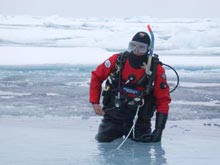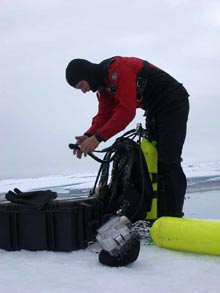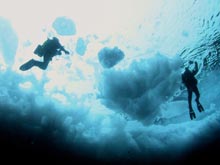
Wayne Smith, DFO Winnipeg, in his drysuit working his way back onto an ice floe after a dive in the Canada Basin. Click image for larger view.
Diving Under The Ice Floes
Katrin Iken
Assistant Professor and Scientific Diver
University of Alaska Fairbanks
Ice floes of varying sizes, pressure ridges, crevices - all these are typical components of the high Arctic Ocean pack ice system. The life associated with the sea ice is one important component to be studied during the 2005 Hidden Ocean cruise. This year, a group of scientists will get intimately familiar with the ice because three members of the science team are scientific divers. They will don their drysuits and collect samples and video footage of organisms under the sea ice.
While much of under-ice diving is similar to regular diving, there are a few important differences. First, the divers wear drysuits instead of wetsuits. These dry suits are sealed at the wrist and the neck and don't let any water in beyond the seals. Underneath the drysuit, the ice-diver wears thick polypropylene underwear to keep warm. A hose connects the drysuit to the air tank and allows the diver to let air into the suit to compensate for increasing external pressure as the diver goes deep underwater. Areas of the body that do get exposed to the cold water are the hands and head. A thick neoprene hood and thick gloves provide some thermal protection, although the hands still get cold because there is a trade-off between the thickness of gloves and dexterity to use sampling equipment.
Under-ice diving is usually performed using compressed air, not other mixed gases. The diver breathes air out of a tank via a regulator that reduces the high tank pressure to ambient (surrounding) pressure. The regulators used during ice-diving are specifically designed to be used in very cold water . They will maintain their proper functioning at temperatures below freezing and have a decreased risk of icing up. A freeze-up will usually result in air flowing freely out of the regulator, which will deplete the tank pressure very quickly.
Most different from regular diving operations, under-ice divers are tethered to the surface. On the surface, a dive tender holds on to the tether and can communicate with the diver via a code of short pulls on the rope. Every diver under the ice always has to be tethered to the surface because it is very hard to keep orientation under the ice. During regular diving, maintaining orientation is not much of a problem because the diver can just come to the surface, re-orient, and continue the dive or surface-swim back to land or the boat. During under-ice diving this is not possible. The sea ice creates a solid lid on the surface and does not allow the diver to come up at any location. Using a tether is the main safety measure during ice diving.
The Arctic dive team will not only dive under the sea-ice, they will also take samples of sea-ice. This creates another difference from the regular diving experience. Usually, divers stay close to the bottom to observe or study marine life. In the case of sampling sea-ice over the deep Arctic Ocean basin, the solid surface they will sample is above the diver and underneath is 3000m of water column. This requires the diver to behave differently and adjust the swimming and diving techniques to this new situation. And again, the tether is an invaluable safety tool to prevent accidental sinking into the ocean depths.


































